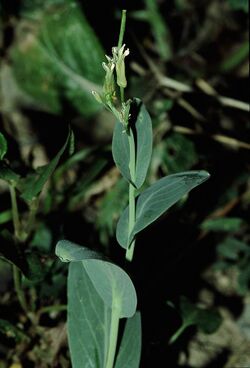Biology:Conringia orientalis
| Conringia orientalis | |
|---|---|

| |
| Scientific classification | |
| Kingdom: | Plantae |
| Clade: | Tracheophytes |
| Clade: | Angiosperms |
| Clade: | Eudicots |
| Clade: | Rosids |
| Order: | Brassicales |
| Family: | Brassicaceae |
| Genus: | Conringia |
| Species: | C. orientalis
|
| Binomial name | |
| Conringia orientalis | |
Conringia orientalis is a species of flowering plant in the mustard family known by the common name hare's ear mustard.[1] It is native to Eurasia but it is known elsewhere as an introduced species and sometimes a noxious weed. It is weedy in its native range and also in North America, where it is a widespread invasive species, especially in central Canada.[2]
It is an annual herb producing an unbranched erect stem 30 to 70 centimetres (12 to 28 inches) in height. The thick, waxy leaves are generally oval in shape, up to 9 centimetres (3 1⁄2 inches) long, and clasp the stem at their bases. The flower is enclosed in pointed sepals and has yellow, clawed petals about 1 centimetre (1⁄3 inch) long. The fruit is a beaded silique up to 13 centimetres (5 inches) long. The plant is known to be toxic to livestock.[2]
References
- ↑ "Conringia orientalis". Natural Resources Conservation Service PLANTS Database. USDA. https://plants.usda.gov/core/profile?symbol=COOR. Retrieved 17 January 2016.
- ↑ 2.0 2.1 North American Plant Protection Organization
External links
- Jepson Manual Treatment
- {{citation
| mode = cs1 | title = Conringia orientalis | work = Germplasm Resources Information Network (GRIN) | url = | publisher = [[Organization:Agricultural Research ServAgricultural Research Service (ARS), United States Department of Agriculture (USDA) | access-date = }}
Wikidata ☰ Q159195 entry
 |

